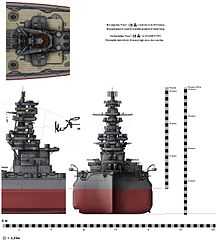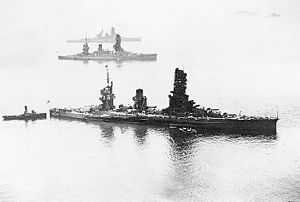Pagoda mast



The pagoda mast was a type of superstructure that was common on Japanese capital ships that were reconstructed during the 1930s in a bid to improve their fighting performance. These modifications were deemed to be necessary by the Imperial Japanese Navy as a result of the "Battleships Holiday" that was imposed by the Washington Naval Treaty, which strictly limited the construction of new battleships.[1]
Pagoda masts featured a mass of platforms that included watch points, searchlights, and spotting points. The superstructures were constructed on the majority of the ships that were rebuilt by the Japanese, including the Kongō-class battlecruisers and the Fusō, Ise, and Nagato-class battleships. The additional platforms were supported on the ships' original tripod foremasts (a design also extensively used by the Royal Navy) and these were suitably strengthened to bear the extra weight they had to carry.
Like the British Royal Navy, which was considered to be the likely enemy of Japan in the event of an armed conflict, the Imperial Japanese Navy wanted to prepare their warships for engaging in combat during the night. Prior to the outbreak of World War II, powerful searchlights were placed on the pagoda masts for the purpose of illuminating enemy ships at night. However, during the early 1940s, the searchlights mounted on the pagoda became less important as new radar technology was developed that allowed a ship to aim and shoot at targets located "over the horizon".[2][3]
In the navies of Europe and the Americas, tall pagoda-style masts were generally frowned upon. Naval architects and sailors from the Western hemisphere claimed that the Japanese battleships were too "top-heavy" and critics often mocked these vessels by nicknaming them "Christmas Trees". Regardless of how valid these criticisms actually were, some of the pagoda masts that were built on Japanese warships during the 1930s were indeed very large. For instance, the top of the pagoda mast of the Imperial Japanese battleship Fusō was 40 metres (130 ft) above the waterline.
References
- ↑ http://www.ibiblio.org/pha/pre-war/1922/nav_lim.html
- ↑ http://www.combinedfleet.com/radar.htm
- ↑ Nakajima, S.; “Japanese radar development prior to 1945,” IEEE Antennas and Propagation Magazine, vol. 34, Dec., 1992, pp. 17-22